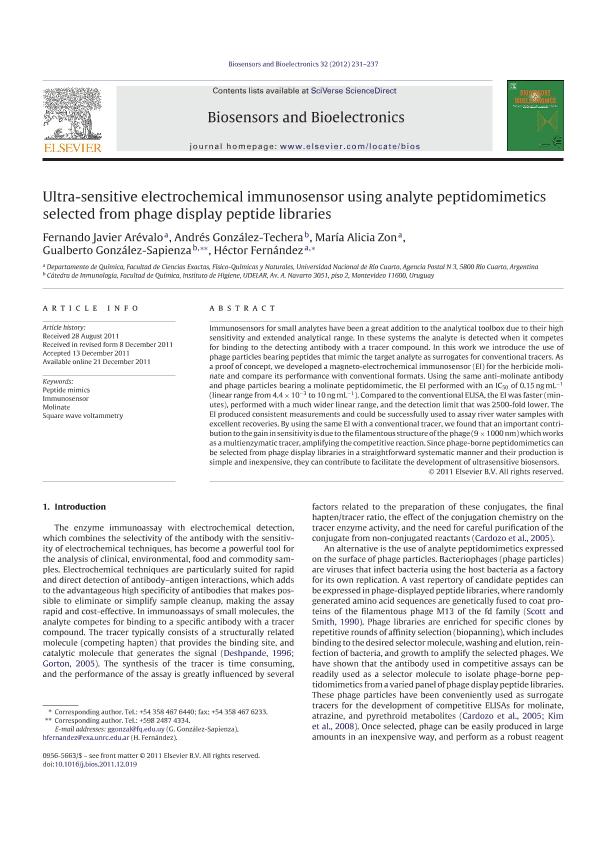Mostrar el registro sencillo del ítem
dc.contributor.author
Arevalo, Fernando Javier

dc.contributor.author
González Techera, Andrés
dc.contributor.author
Zon, María Alicia

dc.contributor.author
González Sapienza, Gualberto
dc.contributor.author
Fernández, Héctor
dc.date.available
2023-05-30T19:35:48Z
dc.date.issued
2012-02
dc.identifier.citation
Arevalo, Fernando Javier; González Techera, Andrés; Zon, María Alicia; González Sapienza, Gualberto; Fernández, Héctor; Ultra-sensitive electrochemical immunosensor using analyte peptidomimetics selected from phage display peptide libraries; Elsevier Advanced Technology; Biosensors & Bioelectronics; 32; 1; 2-2012; 231-237
dc.identifier.issn
0956-5663
dc.identifier.uri
http://hdl.handle.net/11336/199088
dc.description.abstract
Immunosensors for small analytes have been a great addition to the analytical toolbox due to their high sensitivity and extended analytical range. In these systems the analyte is detected when it competes for binding to the detecting antibody with a tracer compound. In this work we introduce the use of phage particles bearing peptides that mimic the target analyte as surrogates for conventional tracers. As a proof of concept, we developed a magneto-electrochemical immunosensor (EI) for the herbicide molinate and compare its performance with conventional formats. Using the same anti-molinate antibody and phage particles bearing a molinate peptidomimetic, the EI performed with an IC 50 of 0.15ngmL -1 (linear range from 4.4×10 -3 to 10ngmL -1). Compared to the conventional ELISA, the EI was faster (minutes), performed with a much wider linear range, and the detection limit that was 2500-fold lower. The EI produced consistent measurements and could be successfully used to assay river water samples with excellent recoveries. By using the same EI with a conventional tracer, we found that an important contribution to the gain in sensitivity is due to the filamentous structure of the phage (9×1000nm) which works as a multienzymatic tracer, amplifying the competitive reaction. Since phage-borne peptidomimetics can be selected from phage display libraries in a straightforward systematic manner and their production is simple and inexpensive, they can contribute to facilitate the development of ultrasensitive biosensors.
dc.format
application/pdf
dc.language.iso
eng
dc.publisher
Elsevier Advanced Technology

dc.rights
info:eu-repo/semantics/openAccess
dc.rights.uri
https://creativecommons.org/licenses/by-nc-sa/2.5/ar/
dc.subject
IMMUNOSENSOR
dc.subject
MOLINATE
dc.subject
PEPTIDE MIMICS
dc.subject
SQUARE WAVE VOLTAMMETRY
dc.subject.classification
Química Analítica

dc.subject.classification
Ciencias Químicas

dc.subject.classification
CIENCIAS NATURALES Y EXACTAS

dc.title
Ultra-sensitive electrochemical immunosensor using analyte peptidomimetics selected from phage display peptide libraries
dc.type
info:eu-repo/semantics/article
dc.type
info:ar-repo/semantics/artículo
dc.type
info:eu-repo/semantics/publishedVersion
dc.date.updated
2023-05-30T11:50:14Z
dc.journal.volume
32
dc.journal.number
1
dc.journal.pagination
231-237
dc.journal.pais
Países Bajos

dc.journal.ciudad
Amsterdam
dc.description.fil
Fil: Arevalo, Fernando Javier. Consejo Nacional de Investigaciones Científicas y Técnicas. Centro Científico Tecnológico Conicet - Córdoba; Argentina. Universidad Nacional de Río Cuarto. Facultad de Ciencias Exactas Fisicoquímicas y Naturales. Departamento de Química; Argentina
dc.description.fil
Fil: González Techera, Andrés. Universidad de la República; Uruguay
dc.description.fil
Fil: Zon, María Alicia. Consejo Nacional de Investigaciones Científicas y Técnicas. Centro Científico Tecnológico Conicet - Córdoba; Argentina. Universidad Nacional de Río Cuarto. Facultad de Ciencias Exactas Fisicoquímicas y Naturales. Departamento de Química; Argentina
dc.description.fil
Fil: González Sapienza, Gualberto. Universidad de la República; Uruguay
dc.description.fil
Fil: Fernández, Héctor. Universidad Nacional de Río Cuarto. Facultad de Ciencias Exactas Fisicoquímicas y Naturales. Departamento de Química; Argentina
dc.journal.title
Biosensors & Bioelectronics

dc.relation.alternativeid
info:eu-repo/semantics/altIdentifier/url/https://www.sciencedirect.com/science/article/pii/S0956566311008141
dc.relation.alternativeid
info:eu-repo/semantics/altIdentifier/doi/http://dx.doi.org/10.1016/j.bios.2011.12.019
Archivos asociados
